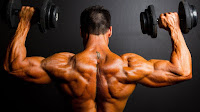The overhead press gives you a lot of bang for your buck. You can use it with heavy weights or for endurance, or both.
Weightlifting inspired exercises such as the clean and press and the snatch grip high pull are also a great addition to your sessions, although they’re more technical. Stick to moderate weights, low reps (up to 6) and high bar speed with those.
If you combine high reps on isolation exercises, do strength work on the overhead press, and do power sets with weightlifting variations, you have all the ingredients to build 3D shoulders.
Shoulders are a smaller muscle group and tend to handle a ton of volume, so I like to train them several times each week. The front delts get hit a lot with pressing movements, so I like to train the medial/rear delts several times a week with movements like upright rows, side raises, etc Nothing beats the strict barbell press for me. I had great success doing sets of 3 one week and sets of 8 to 10 the next. I got up to a 215 pound triple (a 25-pound improvement) and my shoulders and traps blew up!Ironically I see the best hypertrophy with less pressing and more isolation lateral-type movements, especially those focusing on posterior deltoids.
This muscle can make your shoulders look massive, especially when viewed from the side, but most are too lazy to do it as it isn’t as manly as an overhead press. Increase frequency as well. Your shoulders will recover well from lateral variations, which means you can hit them more often. The other nice thing about this approach is that it’s very good for longevity. Your joints will thank youWhen it comes to getting big shoulders, the old standby advice of “get stronger in a variety of rep ranges” still holds true
.
Shoulders tend to respond best to heavy weight, followed by some lighter, higher rep training.
For heavy lifting, stick to the 4 to 6 rep range on compound movements like the overhead press or upright rows.
Note: Upright row can cause impingement issues for some people (especially when going heavy) so I recommend using single-arm dumbbell upright rows, which help eliminate that problem. Of course most compound chest and back exercises will also work your shoulders, so make sure not to overdo it.
A lot of people find that they’re overhead pressing strength goes to crap after benching (and vice versa), so it’s a good idea to work them on separate days. If you’re using heavy upright rows, the same would be true for rowing and pulling.
For the higher rep stuff, stick to the 10 to 15 rep range using isolation exercises like lateral raises. You really want to maximize the size of the lateral delts to give your shoulders a wider appearance, and lateral raises do a great job of this.
Front raises and rear delt flyes are other great isolation moves that target the anterior and posterior heads, respectively. The anterior head typically doesn’t need any extra work, so prioritize the lateral and posterior heads.
Finally, make sure to take care of your rotator cuff muscles with very light, very high rep shoulder stability exercises like external rotations, internal rotations, face pulls, etc. Also be sure to include plenty of mobility work for any tight areas (usually the anterior delts).
The shoulder is a complex joint that can be highly susceptible to injury, and you won’t be able to train for big shoulders if you can’t even lift your water bottle.
Finally, just to reiterate: If you want big shoulders, you MUST get stronger. Make strength gains a priority and you’ll be happy with the results.



Comments
Post a Comment